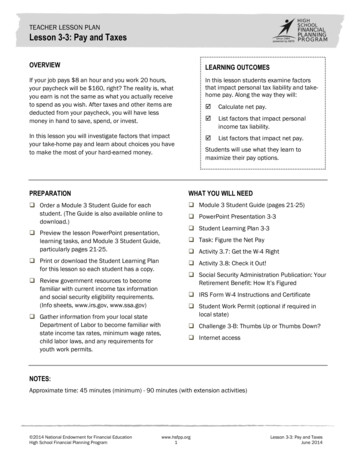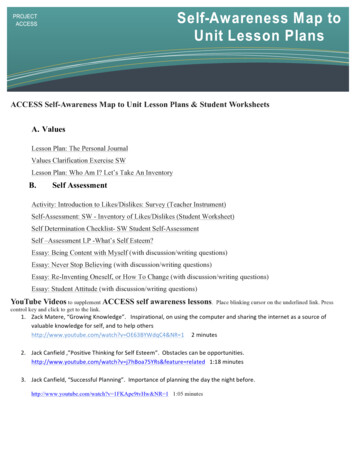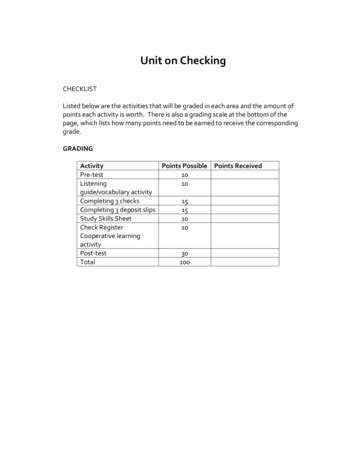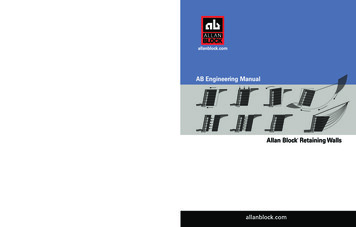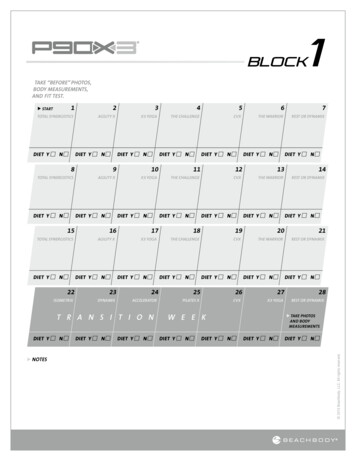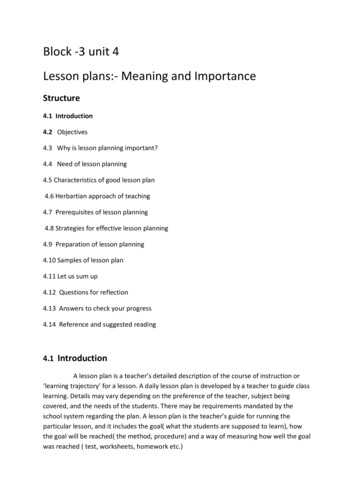
Transcription
Block -3 unit 4Lesson plans:- Meaning and ImportanceStructure4.1 Introduction4.2 Objectives4.3 Why is lesson planning important?4.4 Need of lesson planning4.5 Characteristics of good lesson plan4.6 Herbartian approach of teaching4.7 Prerequisites of lesson planning4.8 Strategies for effective lesson planning4.9 Preparation of lesson planning4.10 Samples of lesson plan4.11 Let us sum up4.12 Questions for reflection4.13 Answers to check your progress4.14 Reference and suggested reading4.1 IntroductionA lesson plan is a teacher’s detailed description of the course of instruction or‘learning trajectory’ for a lesson. A daily lesson plan is developed by a teacher to guide classlearning. Details may vary depending on the preference of the teacher, subject beingcovered, and the needs of the students. There may be requirements mandated by theschool system regarding the plan. A lesson plan is the teacher’s guide for running theparticular lesson, and it includes the goal( what the students are supposed to learn), howthe goal will be reached( the method, procedure) and a way of measuring how well the goalwas reached ( test, worksheets, homework etc.)
4.2 ObjectivesAfter going through this unit, you will be able to: Create a well organized lesson planUnderstand the needs of the student and learning styleBe prepared and confident while teaching in the classroomHelp the students to achieve the aim/objective of the lesson4.3 Why is lesson planning important?Every teacher is required to prepare a lesson plan because this is considered asguide for the day’s lessons. Lesson planning is important because it gives the teacher aconcrete direction of what she/he wants to take up for the day. Research has shown thatstudent learning is correlated to teacher planning. One major explanation is that when planis ready, teachers can focus on its implementation. When teachers do not have to think somuch about what they need to do next they are able to focus on other parts of the lesson.Lesson planning is important because it helps teachers ensure that the day-to-dayactivities that go on in their classrooms are providing students with an adequate level oflong –term progress toward the goals outlined in their scope and sequence, as well as theirindividual education plans when necessary.An effective lesson plan includes several elements: learning objectives, qualityquestions, supplies and activities. It is important to have the learning objectives in mindbecause those should drive the development and implementation of all activities in theclassroom. Quality questions are inquiries that the teacher plans to direct at the studentsover the course of the lesson. Sometimes these questions are rhetoric in nature, but moreoften they are designed to help the student think at a higher level than simple memorizationand comprehension. It is important to come up with a plan for assessment to determinewhether the class has met its targets.Lesson planning is a complex yet essential part of the teaching process thatchanges over time as teachers gain more hands-on experience.4.4 Need of lesson planningFAIL TO PLAN PLAN TO FAIL
Through lesson planning the subject is organized properly.It keeps the teacher free from the faults of thoughtless teaching.It makes the proper atmosphere for learning process.The teacher also gets a clear idea about when they should start evaluation andwhen they should proceed to the next lesson.Lesson plans helps in organized teaching and saves time.Lesson plans allow the teacher to apply appropriate strategy.Teacher will be more prepared and confident while teaching the lesson.4.5 Characteristics of good lesson planningLearning to plan is just like any other skill. It takes time and practice. At firstlesson planning may seem like a time consuming process but by creating detailed lessonplans as a beginner teacher one is able to develop routines that can become moreautomatic over time.1) Lesson planning should be in a written form.2) In lesson planning, the general and important objectives should be clearly defined.3) The lesson plan should relate to suitable teaching method and its use.4) A continuity component reviews and reflects on content from the previous lesson.5) Subject, time , class, average age of the students should be mentioned in the lessonplan.6) Important examples should be included in lesson planning.7) Inspirational or motivational methods should be experimented in lesson planning.8) In lesson planning, the time for each topic should appropriately be pre determined.9) In lesson planning, the techniques and supportive materials of education like charts,maps and other audio-visual materials and its utilization should be written.I have always realized that when you start teaching it is 90% planning and 10%management. But for an experienced teacher, it is 10% planning and 90% management. If,having developed a set of effective management skills and teaching routines, havingexperienced how to be resourceful with very little, and above all having learned to trustyour learners, you are ready to fly on your own. It’s then that you will experience the(almost) unbearable lightness of teaching.
4.6HERBARTIAN APPROACH OF TEACHINGWhile Herbart emphasized only four steps, i.e. clarity, association, system andmethod, his followers modified the four steps. Thus, the five steps are termed as Herbartianfive steps of teaching.Preparation/IntroductionSome questions are asked from the pupils in order to test their previousknowledge so that curiosity may arouse in them for learning of new knowledge. By testingtheir previous experiences pupils are prepared for acquiring new knowledge.Statement of aimHere, the topic becomes clear to the pupils and the teacher himself is supposed towrite the topic on black- board in clear words.PresentationThe lesson is developed with the cooperation of the pupils. Opportunities areprovided to pupils to learn themselves by stimulating their mental activity. The teacher triesto receive most of the point from the pupils by questioning so that the new knowledge mayget related to the previous knowledge.Comparison and AssociationIn this, the facts, events and application taught are related mutually bycomparison to enable the pupils to understand the taught material. The teacher establishesa relationship between two subjects and also between the facts and events of one subjectand the facts and events of other subject. The compares them so that the new knowledgemay get stabilized and clarified in the minds of the pupils.GeneralizationHerbart termed this step as ‘system’. After explaining the main lesson, the pupilsare provided with opportunities to think. They formulate such principles and rules whichmay be used in various situations of the future life.ApplicationIn Application it is observed whether the acquired knowledge may be applied to thenew situations. The teacher verifies this by asking recapitulate question or by providingopportunities to apply the acquired knowledge in the new situations. This stabilizes the newknowledge and validity of the rules may also be proved.
HERBARTIAN LESSON PLAN MODELDate .Class Period Subject Topic .1.General ObjectivesThese objectives are formulated by the teacher in his subject keeping in view the enteringbehaviors of the learners. For example: 1. to develop the knowledge of grammar among thestudents.2.Specific ObjectiveThese objectives are formulated on the basis of general objectives and considering thenature of the topic and level of students. These are specified in terms of knowledge, skill orappreciation. These objectives are written in behavioral terms. For Example:(i) Students willbe able to recall the definition of noun. (ii) Students will be able to enumerate the examplesof noun.3.Introduction.Here, the teacher employs his insight and experiences for liking new knowledge with theprevious knowledge of the students. The topic is not introduced directly but it is usuallyemitted by the students’ responses by asking introductory questions.4.Teaching AidsAudio-visual aids are selected according to the proposed topic.5.Previous knowledgeStudents’ previous knowledge is mentioned. For example: Students are familiar with figureof speech. They know that nouns are naming words.6.Statement of AimThe teacher gives his statement of teaching topic by incorporating the students’ responses.For Example: “Today, we will study about the noun and its kinds.”7.Presentation
The teacher prepares the developing questions after introducing the topic. The questionare arranged in logical sequence, i.e., from simple to complex, considering the structure ofthe topic.8.ExplanationThe teacher is supposed to explain the answers of the given developing question. As wholeof the content-matter is in the question-answer form.9. Black board SummaryThe teacher has to prepare the black-board summary of his teaching point and explanations.10.Review QuestionsThe purpose of these questions is to practice the students’ learning and to evaluate theirperformance whether they have comprehended the teaching unit or not. These reviewquestions are asked only after rubbing the black-board summary. For example:Q.1.What is the definition of Noun?Q.2. Give some examples of Noun .11.Home assignmentsAt the end of the lesson plan, home assignment is given to the students on the sameteaching unit. The purpose of home work is to practice, to organize and to study the topicfor better understanding and retention.Advantages1.Organized TeachingEach step has been organized in a logical order which provides an opportunity to the freshteacher to become aware of future mistakes. Originality is never affected and the teachinggoes on in a very organized way.2.Acquiring thoughts as apperception.Herbart believed that when the new thought related to the thoughts lying in unconsciousmind of the pupils are presented, the thoughts of unconscious mind come to the consciousmind, establish relationship with the new thought and again go to the unconscious mind.Herbart termed this material process of acquiring thoughts as apperception.3.Use of Inductive and Deductive MethodsWhile presenting the new knowledge, help of various examples is sought throughgeneralization and rules are derived. It is an inductive method. In the step application, these
rules are to be executed, this is a deductive method. Thus, both indicative and deductivemethods are used in this five steps approach.4. RecapitulationSuch question is asked while recapitulating which, on answering, result in the learning andapplication of the acquired knowledge in new situations.5. Correlation PossibleHerbart considered entire knowledge as a single unit. The knowledge of the pupils isacquired in a single unit. This allows to establishing a correlation between previous and newknowledge and between all subjects of the curriculum.Disadvantages1.Mechanical Method of TeachingThe use of these steps takes away the freedom of the teacher as he cannot incorporate hisindependent thought in any step. This reduces his originality. Hence, Herbartian approach isa mechanical method of teaching.2.No Place for Individual DifferencesWhile using Herbartian approach. Similar questions are asked to the entire. This overlooksindividual differences.3.Useful in Knowledge Lesson onlyHerbartian approach is useful in the knowledge lesson only, not in appreciation and skilllessons.4.Teacher More ActiveIn Herbartian approach, the teacher has to be more active. It is more desirable if the pupilsremain more active than the teachers. As this teaching method is not activity-centered,pupils don’t get any motivation for learning.5.No need of GeneralizationGeneralization is not needed while teaching language, geography, history, music and artsetc. Thus, all the five steps are not needed while teaching.6.UninterestingThis approach stresses upon the teaching of all the subjects of curriculum in a similarsequence overlooking the interests, attitudes, abilities, and capacities of the pupilsaccording to their mental development. The entire teaching becomes monotonous. The
pupil does not show any interest in acquiring new knowledge. Thus, Herbart‟s teachingmethod is not interesting7.Difficulty of Correlation.Considering the knowledge as a complete unit, Herbart emphasized correlation betweendifferent subjects for the unity in the mental life of the pupils, but following these five stepsteachers impart the knowledge of different subjects to the pupils differently. They seek toestablish a correlation between various subjects in order to bring integration in the mentallife of the pupils which is essentially difficult, if not impossible. So, in nutshell it can beconcluded that Herbartain Five-Step Approach, is an impressive and psychological teachingmethod. It includes both inductive and deductive methods. A correlation among all thesubjects of the curriculum is possible by its use. There is a provision of recapitulation in thestep under application.However, some educationists point out that this method is useful onlyfor knowledge lessons. Generalization is not needed in every lesson. Herbart’s method ismechanical. There is no place for individual differences. It does not motivate the pupils tolearn by doing. The correlation between the different subjects is essentially difficult. Glowerpoints out that in Herbartian approach, emphasis is laid on teaching only instead of learning.This reduces the freedom of the teacher. Pupils also become passive. Neither is theircharacter formed nor do they reach their desired goals. However, the pupil-teachers shouldfollow this approach with necessary changes keeping its merits in view.Check Your ProgressNote: a) Write your answer in the space provided after each item.b) Compare your answers with those given at the end of the unit.1. Write 6 characteristics of good lesson ---------------
A lesson plan is a teachers detailed description of the course of instruction or learning trajectory for a lesson. A daily lesson plan is developed by a teacher to guide class learning. Details may vary depending on the preference of the teacher, subject being covered, and the needs of the students. There may be requirements mandated by the



